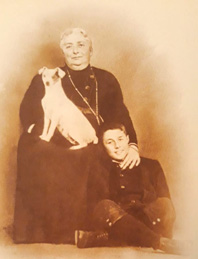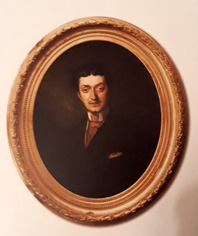
Achille Murat - Country of Liquid Sun
Tuesday, April 14
David Dadiani, son of Levan Dadiani and the Ruler of Samegrelo, died on 30 August 1853. On 20 September, Vorontsov, the Tsar's Governor General and Commander-in-Chief of the Caucasus, informed His Highness in St-Petersburg that the title of the Ruler of Samegrelo was to be granted to Dadiani's elder son, Niko, after his death. The younger Dadiani was only seven years old when his father died. Until he reached the age of 20, his mother, Ekaterine Chavchavadze, had the responsibility of ruling Samegrelo. A Board of Advisors, consisting of the Ruler's brothers-Guards Colonel Prince Grigol and Captain Prince Konstantine Dadiani and the Archbishop of Samegrelo, Zakaria-was created in order to help Ekaterine in her duty.
A peasants' rebellion broke out in the Samegrelo region in the spring of 1857. Upon her return from St-Petersburg after attending the ceremony of inauguration of Emperor Alexander II, Ekaterine was frustrated by the situation in Samegrelo and asked Russia for help once again.
Appealing to Kolubyakin, the Military Governor of Kutaisi, to send in the Russian Army to suppress the peasants' rebellion, he himself led the Army to Samegrelo although Russian officials were deliberately delaying their active involvement in the processes. Instead, they were artificially creating all pre-conditions for Ekaterine to resign as the authority of the Ruler and introduce Russian governance in Samegrelo.
Russian tried all possible ways to make Ekaterine resign, including trying to convince in her or, better to say, deceive her that the hereditary rights of the under-age Niko would be preserved and the governance of the region Samegrelo would be entrusted to Russian officials only temporarily and in the period following the tense situation. In fact, they ignored Ekaterine's feelings of offence at what was happening which she expressed openly in regard to the existing situation.
Ultimately, the Russian goal was achieved and Ekaterine was recalled to St- Petersburg Samegrelo, as a princedom, was abolished.
Ekaterine lived in St-Petersburg for 25 years. She also lived in other places in Russia as well as in France and Germany before she finally returned to Samegrelo where she died in 1882 at the age of 66 in the village Gordi. She was buried in Martvili, next to her husband, the last Ruler of Samegrelo, David Dadiani.
Achille, the grandson of Joachim Murat, the King of Naples, set close relations with Ekaterine's family whilst living in Paris. In 1868, he married Salome, the daughter of David Dadiani and Ekaterine Chavchavadze.
Achille Charles Louis Napoleon Murat belonged to a royal family. He was mainly in military service and participated in battles. He was highly esteemed by the French Royal court, more so than was his grandfather, the King of Naples, Joachim Murat, who was married to the sister of Napoleon I. The wedding ceremony and reception of Achille and Salome took place in the church of the Tuilleries Palace and was attended by Napoleon III and the Queen of France which was very emotionally-and in great detail- described by Salome Murat Shaladon, the daughter of Achille Lusiane’s son, in a letter (the letter is now kept in the Zugdidi Historical Museum).
After her marriage, Salome Dadiani was called Princess Salome Murat and was so designated in all written documents.
After the death of Napoleon III in 1883, Achille and Salome moved to Georgia and settled in Samegrelo although maintained contacts with France.
In addition to Zugdidi, they possessed residences in Salkhino and Chkaduashi, Samegrelo region, where they had large vineyards, also in the side of and in Rikhe in the village of Ramie.
After Ekaterine's death, several villages-basically, the left bank of the River Tekhura-came into the property of Salome. Salkhino was its centre and where the palace was located.
Grapes were the family's leading crop in Salkhino and Chkaduashi. They grew foreign-mainly French-as well as local varieties such as Cabernet and Fortuget from amongst the non-native vines and mainly Ojaleshi from those local.
A famous French traveller of the seventeenth century, who knew the varieties and quality of his native wine varieties, praised Samegrelo wines in his records, saying: "Samegrelo wine is beautiful. It's strong and viscous, very pleasant to drink and good for the stomach. You can drink nothing better throughout Asia.”
Murats made a great deal of efforts to plant vineyards in the village Chkaduashi. According to stories, the isolated location, where they were planted, was covered with forests and thick thorn bushes. G. Chihua, who visited these vineyards in Chkaduasi and spoke to Prince Achille Murat, communicated his impressions about this expedition trip in the newspaper Iveria of 25 January 1894.
It should be mentioned that Ojaleshi grapes grew at their best in Salkhino and produced wine of the best quality Murats made wine for local sales as well as for sending to Russia and Europe. There are tens of labels intended for sending to France, written with French inscriptions, in the archives of the Zugdidi Historical Museum. Unfortunately, however, these materials do not show the quantity of wine which was sent to France. The fact that Murats made high-quality wine is also proved by the fact that the wines were regularly invited to exhibitions of agricultural products held in Russian and European cities.
In addition to agriculture, the Murats family was actively involved in many other fields with their interest in natural resources, for example, attracting special attention. It wereas Murats himself who provided a study on lead ore in the laboratory of pharmacist Shavgulidze in Kutaisi. Furthermore, they concluded an agreement which resulted in with Mr Khaburzania the discoverer of an agreement on the ores and their chalk centres in Samurzakhano, together with their discoverer, Khaburzania. Finally, additionally, an agreement between the Princess Antoinette Murat and a researcher by the surname of Alshibaia in regard to lead and silver exploration activities in Svaneti is also preserved in the archives of the Museum in Zugdidi. Murats also conducted lead and silver explorations in Lechkhumi.
Murats were as engaged in financial-economical relations with Russia and Europe including the settlement of accounts and export-import related transactions through the Volga-Kama and Azov-Don Commercial Banks whose centres also operated in St-Petersburg with branches in Tbilisi and agencies in Kutaisi.
Salome Murat's interest in horsemanship is also worthy of note. The hippodrome project, of 1910 and developed by the Tver Horsemanship Society, is preserved in the Museum archives in Zugdidi. In addition to the plan, the project contains sketches and drawings related to the types of taking barriers which still meet many present-day norms and standards.
Salome Murat did not belong to the type of landlords whose activities are restricted only to the control of income-expense statements. She herself led vigorous activities as well as taking on physical work. In fact, the whole family worked as is evidenced from the documents preserved in the archives as well as in periodical publications of the time and including oral history.
The residents of the village of Chkaduashi recall the story which was told by their ancestors about Princess Salome and how she took great care of the vineyard plantations. She used to have vine fastening cords around her waist and as soon as she saw any branch which fell down, she fastened them to the right place. One time, on a Monday as the story goes, a high official from the province of Kutaisi who wanted to meet Salome, visited her at her palace in Chkaduashi. Salome, who was in the vineyard, announced her guest through a servant, saying: "Monday is a work day. Please choose another day for your visit."
Princess Salome knew how to appreciate service and she was gracious, as well. She had granted lands free-of-charge to many peasants and documented their ownership.
Achille Murat is also remembered fondly and with warm feelings. He was known for his diligence, a high level of culture and for the benevolent way in which he treated people. The fact that he brought a unique bronze mask from France, which was once owned by Napoleon Bonapart and which is preserved in the Museum in Zugdidi, is invaluable alongside other items, such as rare European publications, opera claviers and music notes, which he also brought by with him and which remaining as true treasures of the Museum. Whilst Murats and his family introduced European culture to the regions they also did not refrain from adopting local habits and ways.
Owing to serious illness and infirmity, Achille Murat took his own life with a hunting gun on 15 February 1895. His tragic death was followed by rumour and speculation about the true causes of his death but which remain without full explanation to this day.
Princess Salome Murat survived her husband by eight years. After her death, her daughter, Princess Antoinette, took over the administration of the estates in a right which she obtained from her mother in her last will and testament. The Princess Antoinette lived in Kutaisi in 1917-1918, renting a house there as is evidenced by archival materials.
Princess Salome Murat, died on 10 July 1913 whilst in Paris for medical treatment. Her final resting place is in France. Her husband Achille's is in Georgia.






